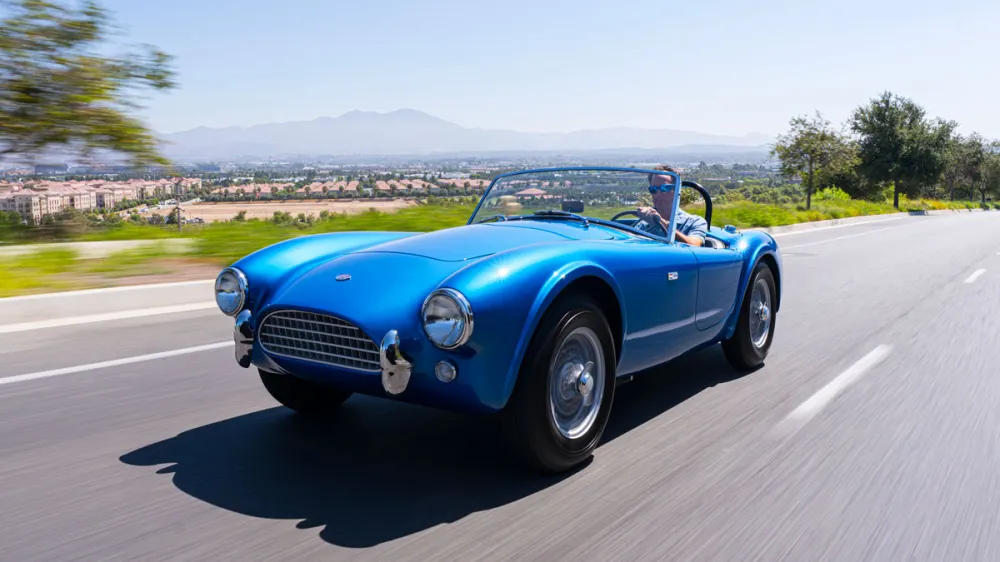This Roadster Is an Ode to the First Shelby Cobra Prototype—Here’s What It’s Like to Drive
Shelby Legendary Cars will make only 10 examples of the Shelby Cobra CSX2000 Tribute Series Roadster, and we drove the initial on
Shelby Legendary Cars has unveiled its latest and perhaps greatest Cobra, the Shelby Cobra CSX2000 Tribute Series Roadster. Other than a fully documented original Cobra, the Tribute Series Roadster aims to establish peak Shelby collectability with an aluminum body inspired directly by the 1962 prototype known as CSX2000, which sold through RM Sotheby’s for $13.75 million in 2016. Only 10 of these homages will be made, each of which can be thought of as a rolling history lesson that revisits the very first Cobra that Carroll Shelby built based on the British AC Ace sports car.
For this run of 10 examples, the CSX2000’s original blueprints are used as direction for hand-forming the aluminum body panels, and the cars come complete with authentic leaf-spring suspension, a period-correct Salisbury rear end, and inboard brakes beneath the skin. Taking what felt like a trip back in time to those early days, before the Shelby legend transformed into an international phenomenon, we recently drove the first Tribute Series Roadster made, piloting it through the scorching hills of Southern California.

Walking up to the vehicle, the so-called “slab sides” make for a relatively tame impression, especially compared to versions of the Cobra from later years, when fenders grew wider to allow the model’s increasingly larger tires to keep up with the engine’s growing displacement. The later big-block V-8 power and raw performance fueled Shelby in racing, and made possible the innovator’s world-beating exploits that eventually included his work on the Ford GT40 and the resultant 1966 Le Mans sweep immortalized in the film Ford v Ferrari.
Yet this tribute to the CSX2000 is not like one of those later cars. Sliding in, the cockpit feels spacious and comfortable thanks to low bucket seats, though, in classic Cobra fashion, the offset pedals do necessitate wearing the narrowest driving shoes possible. Slot the tiny key into the vertical dash, turn it a click clockwise, then push the starter button, and the 280 ci small-block Ford V-8 just happily purrs to life.

Pulling away, the lack of power steering never requires too much muscle because the car simply doesn’t weigh enough to cause any trouble. But the suspension immediately stands out as the most noticeable contrast versus later Cobras. Taut and unforgiving, the leaf springs chop over even moderately smooth road surfaces—despite the high sidewalls of the almost comically narrow tires, not to mention the lightweight body that helps keep overall weight in the low 2,000-pound range.
The transmission shifts easily, with the kind of light “notchiness” that’s appropriate for a “sport car,” as Carroll Shelby famously called his creations. The clutch pedal’s weight and friction zone serve as a highlight, requiring the perfect amount of modulation and providing a level of communication that makes accelerating through the surprisingly short first and second gears an absolute joy. Third gear then takes a big jump up to more serious speed, and it’s easy to imagine that, on a racetrack, flicking back and forth between third and fourth gear would have been the sweet spot back in the day.
Meanwhile, the Salisbury rear end works audibly while distributing power between the rear wheels, especially when the driver rolls off the throttle at lower speeds. And the inboard brakes actually perform remarkably—the only reason Shelby later switched to more typical hub-mounted discs was to make swapping pads and rotors less of a chore, especially in the fire of competition that would forge the Cobra into a legitimate motorsport icon.
Altogether, the completely analog Shelby Cobra CSX2000 Tribute Series Roadster ends up surprisingly easy to drive at a moderate pace. But edge deeper into the throttle and that small block wakes up, clearly preferring the higher end of the tachometer. Finding more pace also loosens up the steering, requiring more attention to keep the narrow front tires in line, plus more heel-toe and clutch work to keep the engine in its happy place—truly, the kind of open-topped driving that attracts so many enthusiasts in today’s overly computerized automotive age.

The less-aggressive exhaust even allows some characterful intake rush to reach the cockpit, too, from the top-mounted air cleaner. Plus, the Tribute Series doesn’t have side pipes, which means no potential for burnt legs while climbing in and out (which Cobra fans call getting “snake bit”).
Without the aggressive fender flares, side pipes, or roaring big-block exhaust, only an expert eye might differentiate a Tribute Series as something special on the road. Yet every example from the extremely limited run will feature true Shelby serial numbers—between CSX2900 and CSX2909—as well as a Manufacturer’s Statement of Origin (MSO) from Shelby American. The chassis and body are sold with the choice of color scheme, and Shelby Legendary Cars can recommend power-train options—obviously, the right thing to do is to spec a small-block Ford V-8 and the Borg Warner T10 transmission, since historical accuracy is the whole point here. Customers can then live out their early-1960s hot-rodder dream by installing the engine and gearbox themselves, or have a shop do the work instead.

The roll hoop on the car we drove is the only non-period-correct concession to safety, which Shelby added to later cars and is a smart idea for buyers who plan to actually drive their Tribute Series Roadsters. And in reality, the rarity and historical significance of these examples is something of a shame, since most of the cars will likely end up parked in collections or museums.
Those handful of owners who do end up driving their tributes will discover just how special and important the original CSX2000 remains, and anything we might call a mechanical flaw actually provides a throughline from the almost primitive AC Ace to the gobsmacking Cobra that made Carroll Shelby a household name in the first place.
